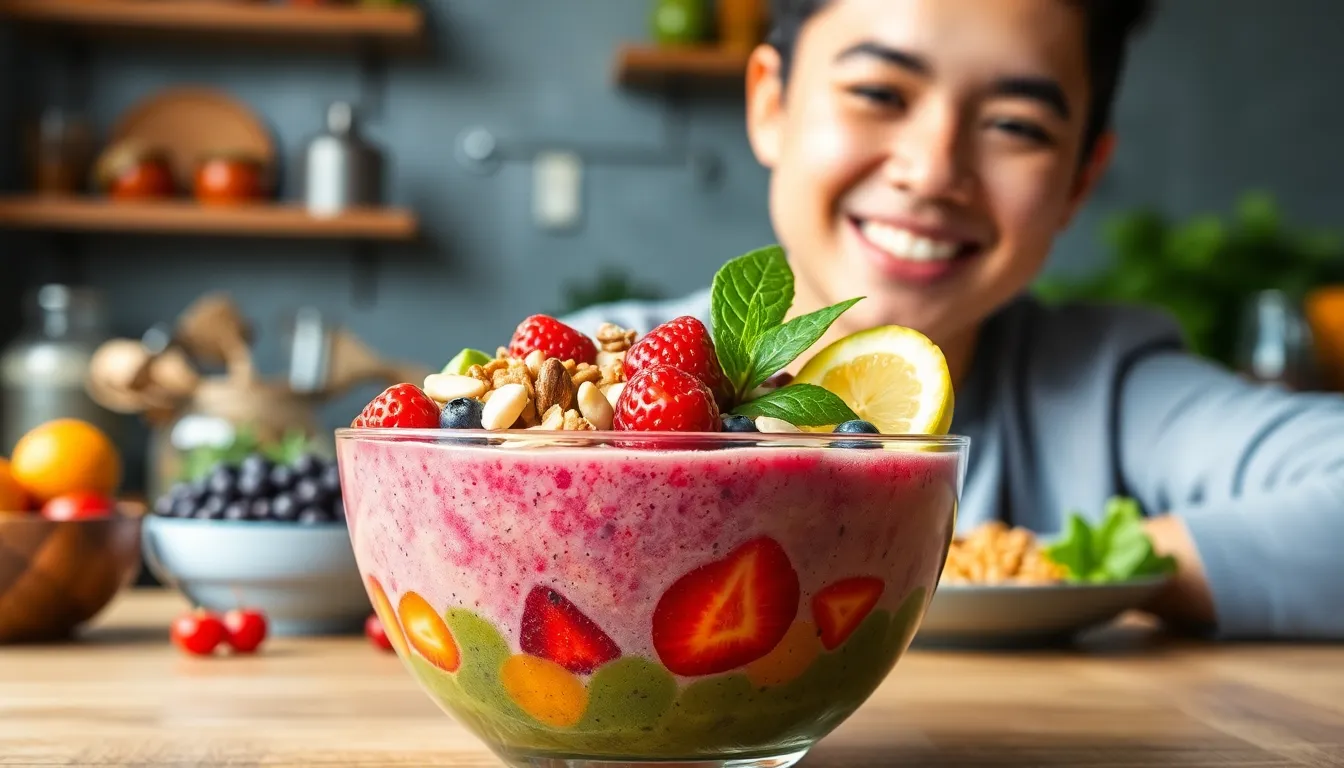Table of Contents
ToggleGen Z is shaking up the food scene like a well-mixed smoothie. With a unique blend of values and preferences, this generation isn’t just eating; they’re making bold statements with every bite. From plant-based everything to TikTok-worthy snacks, their culinary choices reflect a desire for sustainability and creativity.
Gone are the days of boring meals; Gen Z craves experiences that tantalize their taste buds and their social media feeds. Whether it’s the latest avocado toast trend or a quirky dessert that glows in the dark, this generation knows how to keep things fresh and fun. Dive into the delicious world of Gen Z food trends and discover what’s cooking in their kitchens and on their plates.
Overview of Gen Z Food Trends
Generation Z influences food trends with their unique preferences and values. They prioritize sustainability, often opting for plant-based alternatives. Companies develop eco-friendly packaging and ethically sourced ingredients to attract this demographic.
Visual appeal plays a significant role in their food choices. Bright colors and creative presentations are essential, especially in an era dominated by social media platforms like TikTok. Snack items such as colorful smoothies and aesthetically pleasing desserts capture their attention and drive engagement.
Health-conscious options are also crucial for this generation. Many Gen Z consumers seek out nutrient-dense foods, incorporating superfoods like quinoa, chia seeds, and acai into their diets. Meal prep reflects their desire for balance, promoting convenience without sacrificing health.
Experience-driven dining is another key factor. They prefer unique culinary experiences over traditional meals, favoring trendy dishes that excite their palate. Examples include gourmet fusion food and innovative takes on comfort classics.
Food transparency is vital for building trust. They want to know where their food comes from and how it’s produced. Brands that offer clear information about sourcing and ingredient quality resonate more with this audience.
Overall, Gen Z’s food trends highlight their values: sustainability, creativity, health, and experience. The culinary landscape continually evolves to meet the demands of this influential generation. Their preferences shape menus and drive innovation across the food industry.
Popular Ingredients Among Gen Z

Generation Z shows a strong preference for ingredients that align with their values, particularly plant-based foods and sustainably sourced items. These choices reflect their commitment to health and environmental consciousness.
Plant-Based Foods
Plant-based foods dominate Gen Z diets. Many embrace alternatives like lentils, chickpeas, and various plant-based proteins. The rise of meat substitutes, such as Beyond Meat and Impossible Foods, showcases this trend. Recipes featuring cauliflower rice and zucchini noodles frequently appear on social media. Convenience also plays a role, as quick-prep meals with plant-based ingredients become popular with busy lifestyles. Brightly colored smoothie bowls and innovative vegan desserts attract attention. These visually appealing options encourage sharing on platforms like Instagram and TikTok, enhancing overall engagement.
Sustainable Sourcing
Sustainable sourcing resonates with Gen Z values. They support brands that prioritize local ingredients and eco-friendly practices. Organic produce and responsibly caught seafood frequently appear in their favorite dishes. Transparency about sourcing methods influences purchasing decisions, driving consumers to companies with clear ethical standards. Many seek products that minimize environmental impact, such as those using recyclable packaging. This level of awareness fosters brand loyalty, encouraging consumers to choose companies aligned with their values. Overall, sustainable sourcing shapes Gen Z’s food landscape, promoting a culture of responsibility and purpose.
Dining Preferences of Gen Z
Gen Z’s dining preferences reflect their desire for convenience, innovation, and social responsibility. Their choices significantly impact how the food industry evolves.
Convenience and On-the-Go Options
Convenience reigns supreme among Gen Z. Many prefer meals that require minimal preparation and can fit into their busy lifestyles. Ready-to-eat options, such as plant-based bowls and pre-packaged snacks, have gained traction. Quick methods of meal preparation appeal to them, with solutions like meal kits delivering everything needed for a home-cooked experience. Grab-and-go choices align with their fast-paced routines, ensuring they can maintain a healthy diet without sacrificing time. Fast-casual eateries have also seen a rise in popularity, offering fresh, quick meals that cater to their dietary preferences while supporting a busy schedule.
Virtual Dining and Delivery Services
Virtual dining has transformed how Gen Z enjoys food. Delivery services like DoorDash and Uber Eats streamline the process, allowing them to explore diverse cuisines from the comfort of home. Ghost kitchens, which prepare food exclusively for delivery, are also gaining momentum among this generation. Such options provide exciting, unique meals without the need for dine-in experiences. Social media influencers often showcase trendy dishes from these services, further fueling interest. Gen Z appreciates the convenience of order-and-go methods while wanting to support local businesses, understanding the importance of community engagement in their purchasing choices.
Influences on Gen Z Food Choices
Generation Z’s food choices get shaped by various factors that reflect their values and lifestyles. Food trends often emerge from social media. Platforms like TikTok and Instagram serve as key influencers, where vibrant visuals and creative presentations resonate with younger audiences. Users showcase dishes that highlight the appeal of unique flavors and colorful ingredients, making foods like gourmet fusion tacos or smoothie bowls go viral. Interactive content engages viewers, prompting them to recreate trending recipes and share their experiences.
Health considerations also play a significant role in Gen Z’s culinary preferences. Many individuals focus on nutrient-dense options, seeking ingredients that provide both wellness benefits and taste. Superfoods like quinoa, chia seeds, and plant-based proteins frequently appear on their menus. Furthermore, the demand for transparency about ingredient sourcing drives consumers to choose brands prioritizing ethical practices. Convenience remains essential, as ready-to-eat plant-based meals and meal kits cater to busy lifestyles while supporting health goals. This focus on wellness influences not only their personal choices but also the broader food industry trends.
Generation Z’s influence on the food industry is undeniable. Their commitment to sustainability and creativity is reshaping how food is produced and consumed. As they prioritize health and convenience, brands must adapt to meet these evolving preferences.
The rise of visually appealing and innovative dishes reflects their desire for unique culinary experiences. With social media driving trends, companies that embrace these values will thrive.
Ultimately, Gen Z is not just changing what’s on their plates; they’re redefining the entire food landscape for future generations. Their focus on ethical sourcing and vibrant presentations will continue to inspire innovation in the culinary world.







